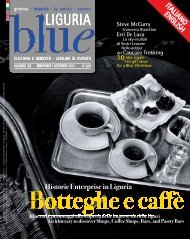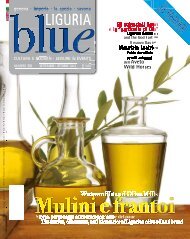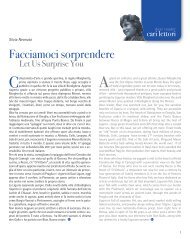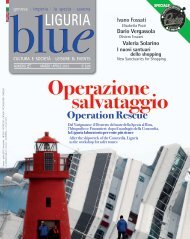Download PDF - Blue Liguria - Sagep
Download PDF - Blue Liguria - Sagep
Download PDF - Blue Liguria - Sagep
You also want an ePaper? Increase the reach of your titles
YUMPU automatically turns print PDFs into web optimized ePapers that Google loves.
lue<br />
cover<br />
La fotoricetta<br />
Genoese pesto<br />
Il Pesto genovese in sette<br />
mosse e pochi, precisi<br />
ingredienti: 4 mazzi di Basilico<br />
Genovese D.O.P, 30 g di pinoli,<br />
45-60 g di Parmigiano Reggiano<br />
Stravecchio grattugiato,<br />
20-40 g di Fiore Sardo<br />
grattugiato (Pecorino Sardo), 2<br />
Spicchi d’Aglio di Vessalico, 10 g<br />
di sale, 60-80 cc di Olio Extra<br />
Vergine di Oliva “Riviera Ligure”<br />
D.O.P.<br />
4 bunches of fresh PDO<br />
(Protected Designation of<br />
Origin) Genoese basil, which<br />
guarantees high-quality taste<br />
and flavour, 30 g pine nuts<br />
445-60 g aged Parmesan<br />
cheese, grated,<br />
20-40 g Fiore Sardo cheese<br />
(Pecorino Sardo), grated,<br />
1-2 garlic cloves from Vassalico<br />
(Imperia), 10 g coarse salt, 60-<br />
80 cc PDO extra-virgin olive oil<br />
from the “Italian Riviera”.<br />
SDP<br />
(Pesto incluso), segnala: «la consapevolezza del<br />
pesto genovese di qualità in America sta crescendo<br />
al passo con l’educazione del palato, ma<br />
è un processo molto lento».<br />
In pratica, i consumatori americani, una volta assaggiato<br />
il Pesto vero, iniziano a notare le differenze:<br />
sentono che il basilico coltivato là ha un<br />
sapore troppo erbaceo e mentolato, si rendono<br />
conto dell’importanza di avere tra gli ingredienti<br />
Parmigiano Reggiano per davvero, distinguono<br />
le produzioni importate da quelle locali per la<br />
qualità dell’olio piuttosto che dei pinoli. Insomma<br />
le vendite aumentano, l’entusiasmo<br />
anche. Il percorso però<br />
è ancora troppo lento. Due<br />
“<br />
Il<br />
gli ostacoli principali: il prezzo<br />
ovviamente più elevato dei prodotti<br />
importati dall’Italia e il<br />
fatto che anche in America si<br />
sta affermando sempre più il<br />
concetto del “locale e sostenibile”.<br />
Ci si accontenta di prodotti<br />
non autentici se sono preparati<br />
con ingredienti che si<br />
possono coltivare vicino.<br />
Dunque, come lavorare su gusto<br />
e autenticità a supporto<br />
delle nostre produzioni locali<br />
Secondo Martina, per aumentare<br />
la popolarità del vero Pesto<br />
genovese «è fondamentale associarlo<br />
alla tecnica artigianale<br />
e tradizionale che occorre per<br />
produrlo, perché rappresenta<br />
sempre un elemento di grande<br />
fascino per gli americani».<br />
Secondo lo chef Danny Bowien<br />
- Genoa Pesto World<br />
Champion nel 2008 quando lavorava<br />
presso un rinomato ristorante<br />
di cucina ligure a San<br />
Francisco come aiuto cuoco<br />
dello chef genovese Paolo Laboa e oggi titolare<br />
di Mission Chinese, negli anni diventato una star<br />
- il parametro di riferimento è sempre la felicità,<br />
creare le condizioni perché le persone stiano<br />
bene (e lui lo fa nei suoi locali con i suoi piatti).<br />
Per i teorici del marketing territoriale, la chiave<br />
del successo per promuovere un territorio e le<br />
sue produzioni tipiche sta nel proteggerne le<br />
peculiarità (in particolare quando fanno cultura<br />
e rappresentano un modo di vivere), nel saperle<br />
comunicare e, al tempo stesso, renderle<br />
accessibili a tutti. Quindi fare il pesto al mortaio<br />
non solo è trendy, ma soprattutto è utile.<br />
parametro di<br />
riferimento della buona<br />
cucina deve essere la<br />
felicità: vanno create le<br />
condizioni perché le<br />
persone stiano bene<br />
The parameters of<br />
reference for good<br />
cooking are set by<br />
happiness. Conditions<br />
must be created so that<br />
people feel good<br />
the U.S. tells us, “the knowledge of quality Genoese<br />
pesto in America is increasing at the same pace as<br />
their ‘education of the palate’ (i.e. their<br />
understanding of gourmet food), but it is a slow<br />
process”.<br />
In practice, once American consumers taste true<br />
Pesto, they suddenly recognize the difference. And<br />
what a difference! American basil tastes of mint,<br />
and herbs. Then for good pesto, you need to add<br />
real parmesan, parmigiano reggiano, not to mention<br />
the important distinctions in olive oil – the<br />
imported versus the local variety, and the same goes<br />
for pine nuts. So sales are<br />
increasing; enthusiasm as well.<br />
But the road is long, and still<br />
”<br />
Danny Bowien,<br />
chef<br />
very slow. Two main obstacles<br />
remain: the price is obviously<br />
higher for products imported<br />
from Italy, and the fact that<br />
even in America the campaign is<br />
being made for “local and<br />
sustainable” production.<br />
Americans accept products that<br />
are not authentic, but can be<br />
made with cheaper ingredients<br />
grown close by.<br />
So how do we work on taste<br />
and authenticity to support our<br />
own <strong>Liguria</strong>n production<br />
According to Martina, by<br />
increasing the popularity of true<br />
Genoese Pesto. “It is essential to<br />
associate the artisan techniques<br />
and traditions which are used to<br />
produce it, because this is always<br />
an element of great fascination<br />
for Americans.”<br />
According to chef Danny Bowien<br />
– Genoa Pesto World Champion<br />
in 2008, when he was working at<br />
a famous <strong>Liguria</strong>n cuisine<br />
restaurant in San Francisco as<br />
assistant cook to the Genoese chef, Paolo Laboa, and<br />
now the owner of Mission Chinese – the parameter<br />
of reference is “happiness”, i.e. to create conditions<br />
which make people feel good (and he does this in his<br />
restaurants and with his dishes). For the theoreticians<br />
of territorial marketing, the key to success in<br />
promoting a territory and its typical production is in<br />
protecting its prime characteristics, its “peculiarities”<br />
if you will (in particular when they represent culture<br />
and a way of life), in knowing how to communicate<br />
this, and, at the same time, make it accessible to all.<br />
So therefore, making Genoese Pesto with a mortar is<br />
not just trendy, but above all useful.<br />
78









